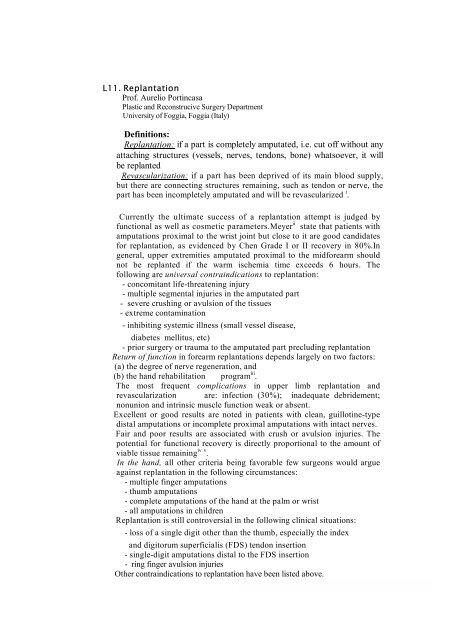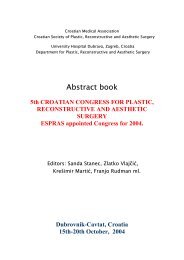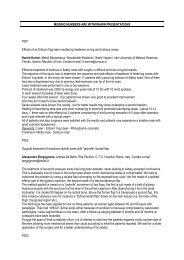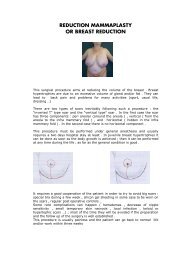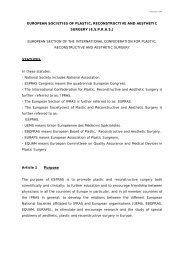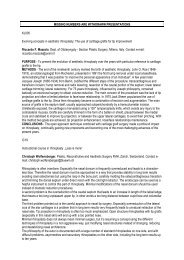Abstract book - ESPRAS
Abstract book - ESPRAS
Abstract book - ESPRAS
You also want an ePaper? Increase the reach of your titles
YUMPU automatically turns print PDFs into web optimized ePapers that Google loves.
L11. Replantation<br />
Prof. Aurelio Portincasa<br />
Plastic and Reconstrucive Surgery Department<br />
University of Foggia, Foggia (Italy)<br />
Definitions:<br />
Replantation: if a part is completely amputated, i.e. cut off without any<br />
attaching structures (vessels, nerves, tendons, bone) whatsoever, it will<br />
be replanted<br />
Revascularization: if a part has been deprived of its main blood supply,<br />
but there are connecting structures remaining, such as tendon or nerve, the<br />
part has been incompletely amputated and will be revascularized i .<br />
Currently the ultimate success of a replantation attempt is judged by<br />
functional as well as cosmetic parameters.Meyer ii state that patients with<br />
amputations proximal to the wrist joint but close to it are good candidates<br />
for replantation, as evidenced by Chen Grade I or II recovery in 80%.In<br />
general, upper extremities amputated proximal to the midforearm should<br />
not be replanted if the warm ischemia time exceeds 6 hours. The<br />
following are universal contraindications to replantation:<br />
- concomitant life-threatening injury<br />
- multiple segmental injuries in the amputated part<br />
- severe crushing or avulsion of the tissues<br />
- extreme contamination<br />
- inhibiting systemic illness (small vessel disease,<br />
diabetes mellitus, etc)<br />
- prior surgery or trauma to the amputated part precluding replantation<br />
Return of function in forearm replantations depends largely on two factors:<br />
(a) the degree of nerve regeneration, and<br />
(b) the hand rehabilitation program iii .<br />
The most frequent complications in upper limb replantation and<br />
revascularization are: infection (30%); inadequate debridement;<br />
nonunion and intrinsic muscle function weak or absent.<br />
Excellent or good results are noted in patients with clean, guillotine-type<br />
distal amputations or incomplete proximal amputations with intact nerves.<br />
Fair and poor results are associated with crush or avulsion injuries. The<br />
potential for functional recovery is directly proportional to the amount of<br />
viable tissue remaining iv v .<br />
In the hand, all other criteria being favorable few surgeons would argue<br />
against replantation in the following circumstances:<br />
- multiple finger amputations<br />
- thumb amputations<br />
- complete amputations of the hand at the palm or wrist<br />
- all amputations in children<br />
Replantation is still controversial in the following clinical situations:<br />
- loss of a single digit other than the thumb, especially the index<br />
and digitorum superficialis (FDS) tendon insertion<br />
- single-digit amputations distal to the FDS insertion<br />
- ring finger avulsion injuries<br />
Other contraindications to replantation have been listed above.


